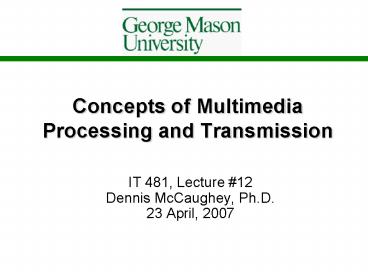Concepts of Multimedia Processing and Transmission - PowerPoint PPT Presentation
1 / 35
Title:
Concepts of Multimedia Processing and Transmission
Description:
Title: PowerPoint Presentation Last modified by: Dennis Mccaughey Created Date: 1/1/1601 12:00:00 AM Document presentation format: On-screen Show Other titles – PowerPoint PPT presentation
Number of Views:66
Avg rating:3.0/5.0
Title: Concepts of Multimedia Processing and Transmission
1
Concepts of Multimedia Processing and Transmission
- IT 481, Lecture 12
- Dennis McCaughey, Ph.D.
- 23 April, 2007
2
Broadcast Network Schematic
- SFN All transmitters operate on a single Radio
Frequency (RF) - MFN Each transmitter operates on a different
frequency
3
Frequency Usage Schematic
4
Terrestrial Drivers
- Terrestrial broadcasts are omnidirectional
- Multiple copies of the same signal may arrive at
the receiver with slightly different delays and
thus interfere with each other - Multipath (direct path signal reflected
signal refracted signal) - Intersymbol Interference (ISI)
- Limits the bit rate that may be achieved
5
Multipath
6
COFDM Channel Interface Components
7
Overhead Bits
8
COFDM Modulator
9
COFDM Transmitter Showing Constellation Mapping
10
Operation
- The OFDM modulator consists of the block in the
diagram that is labeled 'IDFT', which stands for
inverse discrete Fourier transform. - In reality, the actual process carried out is the
inverse fast Fourier transform (IFFT), because
the IFFT is, as the name suggest, a fast way to
calculate the IDFT. - The IDFT calculates the following equation
11
COFDM Receiver
12
COFDM Receiver Showing Constellation Mapping
13
Operation
- The signals are received at the antenna,
- The signals are I/Q down-converted from RF to
generate the real (I) and imaginary (Q) streams, - Low-pass filtered (LPF) and digitized in the
analogue to digital converters (ADC, one ADC for
each stream). - Following the ADC, the cyclic prefix is stripped
off and the remaining sampled values are serial
to parallel converted and once there is a full
block of samples - The DFT is calculated (in reality the FFT is
calculated as the FFT requires far fewer
multiplications to be carried out than the DFT).
14
Symbol Generation
15
Example
- N 5 bits are mapped into 1symbol of duration Ts
- Each symbol bit is modulated onto a different
carrier frequency using on-off keying (OOK) - Carriers are DC, fs, 2fs, 3fs, 4fs
- fs 1/Ts
- Bits Per Carrier
- BPSK 1
- QPSK 2 (4QAM)
- 16QAM 4
- 64QAM 8
- Bits Per Symbol
- BPSK N
- QPSK 2N
- 16QAM 4N
- 64QAM 8N
16
QPSK and QAM Constellations
17
QPSK Bit Rates
18
Receiver Operation
- Receiver waits a short period of time called the
guard interval, Tg, before starting to process
the received symbol - Ensure receipt of all delayed versions of the
direct path signal - Processing entails
- Determining which of the N 5 carriers are
received - Demodulating the subcarrier modulated symbols to
recover the bits (QPSK, 16QAM etc)
19
Why Orthogonality?
- If the subcarriers are orthogonal they do not
interfere with each other - Simplifies the construction and recovery of the
bit-symbol-bit stream sequence - If the subcarriers are cleverly spaced this
orthogonality is preserved in the presence of
multipath - Orthogonality is implemented by spacing the
subcarriers at multiples of 1/Ts
20
What is Orthogonality?
- Two signals x and y are orthogonal if
- If the two signals do not overlap in either time
or frequency they are orthogonal - However the important case here is when they do.
21
Achieving Orthogonality
- Need to define two functions
- Useful Properties
- Fourier Transform Pairs
22
Fourier Transform Pairs
23
Important Fourier Transform Properties
24
Combined Shifting and Scaling
25
Frequency Domain Symbol
26
Guard Interval
- Guard Interval avoids intersymbol interference
- It lowers the maximum encoded bit rate
- Typically Tg Ts/4
- For MFM networks
- For SFN networks
27
Example
- Since a FFT and IFFT are used the nearest powers
of 2 are - 2048 (1705)
- 8192 (6817)
28
DVB-T/H Transmitter
NOKIA
29
DVB-T Frame Format
30
4-Carrier example
- Frame 00,01,10,11
- Modulation QPSK (4QAM)
31
I Signal Plots 0,Ts
32
Q Signal Plots 0,Ts
33
Composite Signal 0,Ts
34
Matlab Code
- N 4
- M 4
- msg_b 0 0 0 1 1 0 1 1
- msg_b reshape(msg_b,2, )
- msg_d 1,2msg_b(,)
- msg_a qammod(msg_d,M)
- A diag(msg_a)
- x zeros(N,128)
- for k 1N
- x(k,) linspace(0,i(k-1)2pi(),128)
- end
- y ones(1,N)Aexp(x)
- plot(real(y),'-r','LineWidth',2)
- hold on
- plot(imag(y),'-b','LineWidth',2)
- legend('I','Q','Fontweight','bold')
- plot(zeros(1,128),'--k','LineWidth',2)
- hold off
- grid on
- Scale eye(N)/sqrt(2)
- Scale(1,1) 1
- figure
- hold on
- plot(real(ScaleAexp(x))','LineWidth',2)
- ylim(-1.1 1.1)
- title('In-Phase Carriers','Fontsize',14)
- legend('00','01','10','11')
- plot(zeros(1,128),'--k','LineWidth',2)
- grid on
- hold off
- figure
- hold on
- plot(imag(ScaleAexp(x))','LineWidth',2)
- ylim(-1.1 1.1)
- title('Quadrature Carriers','Fontsize',14)
- legend('00','01','10','11')
- plot(zeros(1,128),'--k','LineWidth',2)
35
References
- MPEG-4 Natural Video Coding - An overview
Touradj Ebrahimi and Caspar Horne - J. Henriksson, DVB-H, Standards Principles and
Services, Nokia HUT Seminar T-111.590 Helsinki
Finland 2.24.2005 - F. Halsall, Multimedia Communications,
Addison-Wesley, New York, 2001































